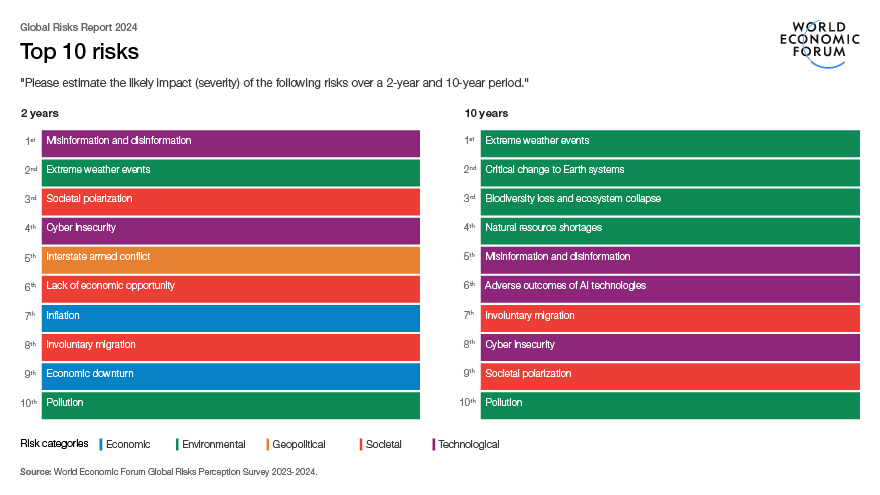
We are pleased to share with you the 19th edition of the Global Risks Report, published by the World Economic Forum in collaboration with Marsh McLennan. Guy Carpenter is a business of Marsh McLennan.
The Global Risks Report is a comprehensive analysis of the most significant risks facing the world today, providing insights into potential challenges and opportunities for leaders in various sectors. It is designed to help you understand the top risks for 2024 and beyond.
Drawing on insights from more than 1,400 experts worldwide, the report unpacks some of the key dangers within the short term and highlights escalating risks over the next decade. The report concludes by considering approaches for addressing complex and non-linear aspects of global risks during this period of global fragmentation.
Global Risks Report 2024
Executive Summary: Global Risks Report 2024
Key findings include
- Environmental risks continue to dominate the risks landscape. Two-thirds of respondents to the Global Risks Perception Survey (GRPS) rank extreme weather as the top risk most likely to present a material crisis on a global scale in 2024, with the warming phase of the El Niño-Southern Oscillation (ENSO) cycle projected to intensify and persist until May this year.
- Societal polarization features among the top 3 risks over both the current and 2-year time horizons, ranking ninth over the longer term. In addition, societal polarization and economic downturn are seen as the most interconnected—and therefore influential—risks in the global risks network, as drivers and possible consequences of numerous risks.
- Emerging as the most severe global risk anticipated over the next 2 years, foreign and domestic actors alike will leverage misinformation and disinformation to further widen societal and political divides. As close to 3 billion people are expected to cast ballots across several economies during the next 2 years, the widespread use of misinformation and disinformation, and tools to disseminate it, may undermine the legitimacy of newly elected governments. Resulting unrest could range from violent protests and hate crimes to civil confrontation and terrorism.
- The convergence of technological advances and geopolitical dynamics will likely create a new set of winners and losers across advanced and developing economies alike. If commercial incentives and geopolitical imperatives, rather than public interest, remain the primary drivers of the development of artificial intelligence (AI) and other frontier technologies, the digital gap between high- and low-income countries will drive a stark disparity in the distribution of related benefits—and risks.
- The cost-of-living crisis remains a major concern in the outlook for 2024. Although a “softer landing” appears to be prevailing for now, the near-term outlook remains highly uncertain. There are multiple sources of continued supply-side price pressures looming over the next 2 years, from El Niño conditions to the potential escalation of live conflicts. And if interest rates remain relatively high for much longer, small- and medium-sized enterprises and heavily indebted countries will be particularly exposed to debt distress.
Click image below for larger version of chart.
